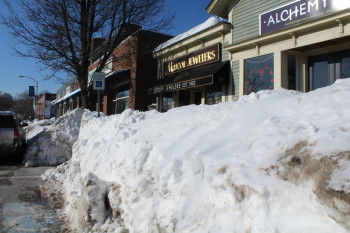Photo: The sidewalk leading to the commuter rail station along Concord Avenue in Belmont Center.
It was bad enough Belmont resident Christina Long had to suffer through stoppages and delays to the MBTA commuter rail system due to the four snow storms that passed through the region in the past month.
She didn’t think it should be as much of a struggle just getting to the Belmont Center station.
Not only did Long need to maneuver through and around sidewalks on residential streets still filled with some of the seven feet of snow that fell on Belmont, she also found walkways on municipal property untouched including the path she uses to reach the station.
“It is amazing that this is the center of town at a busy train station,” Long said after showing a series of photos of her journey to the station.
“What about the regulation that sidewalks need to be cleared of snow? And yesterday when I went for a run, I could not believe that the sidewalk along Concord [Avenue] on the high school property was unplowed,” said Long.
“Why can I not commute to work or go for a run in safety? Has the town government all gone to Florida for the February recess?” she said.
- The sidewalk along Clay Pit Pond on Concord Avenue.
- The walk to the underpass of the commuter rail line in Belmont Center.
- Royal Road.
According to town officials, resources are continuing to be marshaled to make a dent in clearing away snow to allow pedestrians and drivers to travel around Belmont.
“We are currently doing that right now,” said Jay Marcotte, the new Department of Public Work’s Director whose has spent about half of his time since starting the job in January leading the town’s effort to clear snow.
Municipal crews are targeting crosswalks, handicap parking spots, paths and 0ther areas that residents use to get around, said Town Administrator David Kale. The teams are using large and small snow plows as well as shovels to reach a growing number of trouble spots around town.
“Residents know that there are lots of places that need clearing,” said Kale.
Belmont is not alone in literally being snowed under by the four storms – with a fifth forecasted to arrive on Wednesday, Feb. 25; Every municipality in eastern Massachusetts has been straining to get out from under the snowiest 30 day period on record with approximately 90 inches on the ground.
In addition to the DPW’s effort, town inspectors from the Office of Community Development have been enforcing compliance of the town’s municipal snow removal bylaw in the business districts, said Kale.
But Long remains skeptical officials are doing all it can in removing snow from town property.
“How can the town enforce the wonderful snow removal law when they don’t clean their own sidewalks?” she said.
“The lack of clean sidewalks not only affects me and other commuters walking to the train station but it also impacts all the kids walking to school or the library. We are forced to walk on the road,” she said.
And while the town has been successful in making main and side streets passable within 36 hours, it’s difficult to reach every trouble point with the DPW’s Highway Division staff.
The piles of snow has also impacted businesses in Belmont’s three commercial hubs – Belmont Center, Waverley and Cushing squares – as a white wall of now solid slush is hampering commerce.
According to Gerry Dickhaut, owner of Champions Sporting Goods, and president of the Belmont Center Business Association, snow “is overwhelming in the center, it has become a hazard and a safety issue especially to the elderly, the sidewalks are very narrow, crossing the street is dangerous as drivers don’t see the pedestrians with the snow mounds so high.”
Dickhaut said the association of more than two dozen businesses urged the DPW to use its heavy equipment and remove the snow to allow for greater customer access to stores, restaurants, and shops.

That was one request that the town can not accommodate.
“We’re trying to keep up with the problem, but there is a resource issue,” said Kale. While Belmont is doing its best, “Simply put, removing snow from the business districts would be very expensive and time [intensive],” said Kale.
Money is an ever-present concern with the number and severity of the storms so far this year.
Kale said the town’s $600,000 snow removal budget was $175,000 in the red after the first two storms. He can not say the current deficit because the town has yet to tally the bills from the last pair of blizzards.
“We need to be watchful” of how the town is spending, said Kale. The town has approximately $400,000 in reserves that can be used to fill the growing expenditure gap.
Even the town’s success in pushing the snow off the roads has a downside as a field of potholes have emerged on many well-traveled streets. Attempting to travel along Concord Avenue near the library or through Cushing Square have become a game of chicken between the driver and the deep depressions in the road.

“They aren’t potholes,” said one Belmont residents who had traveled on Trapelo Road. “They’re a realignment waiting to happen.”
Marcotte said the DPW has “on our radar” the “real, real bad” potholes around town and emergency repairs will be done. Once the weather “cooperates, we’ll have two crews out” making repairs, said Michael Santoro, the Highway Division’s manager. That would include dry weather and moderating temperatures.
The good news is that some of the most noticeable depressions are in areas that will be completely renovated due to roadway projects; the Trapelo/Belmont project that is now entering Cushing Square and the Belmont Center Reconstruction beginning this spring.


